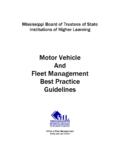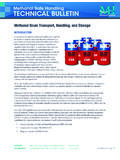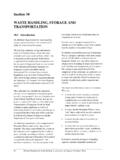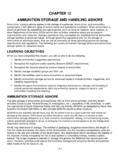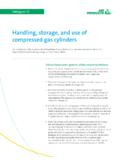Transcription of FLAMMABLE AND COMBUSTIBLE LIQUIDS 29 CFR 1910
1 OSHA Office of Training and Education FLAMMABLE AND COMBUSTIBLE LIQUIDS 29 CFR Definitions FLAMMABLE (Explosive) Limits Container and Portable Tank storage Industrial Plants These materials were developed by OSHA s Office of Training and Education and are intended to assist employers, workers, and others as they strive to improve workplace health and safety. While we attempt to thoroughly address specific topics, it is not possible to include discussion of everything necessary to ensure a healthy and safe working environment in a presentation of this nature. Thus, this information must be understood as a tool for addressing workplace hazards, rather than an exhaustive statement of an employer s legal obligations, which are defined by statute, regulations, and standards.
2 Likewise, to the extent that this information references practices or procedures that may enhance health or safety, but which are not required by a statute, regulation, or standard, it cannot, and does not, create additional legal obligations. Finally, over time, OSHA may modify rules and interpretations in light of new technology, information, or circumstances; to keep apprised of such developments, or to review information on a wide range of occupational safety and health topics, you can visit OSHA s website at 1 FLAMMABLE AND COMBUSTIBLE LIQUIDS 29 CFR INTRODUCTION This discussion covers only two sections of 29 CFR : Container and portable tank storage , and Industrial plants.
3 The primary basis of this standard is the National Fire Protection Association's publication NFPA 30, FLAMMABLE and COMBUSTIBLE LIQUIDS Code. 29 CFR applies to the handling, storage , and use of FLAMMABLE and COMBUSTIBLE LIQUIDS with a flash point below 200oF. There are two primary hazards associated with FLAMMABLE and COMBUSTIBLE LIQUIDS : explosion and fire. In order to prevent these hazards, this standard addresses the primary concerns of: design and construction, ventilation, ignition sources, and storage . DEFINITIONS There are a number of definitions included in 29 These definitions were derived from consensus standards, and were not uniquely developed for OSHA standards.
4 Some of the more important definitions are discussed below. Aerosol: a material which is dispensed from its container as a mist, spray, or foam by a propellant under pressure. Approved: approved or listed by a nationally recognized testing laboratory. Boiling point: the boiling point of a liquid at a pressure of pounds per square inch absolute (psia). This pressure is equivalent to 760 millimeters of mercury (760 mm Hg). At temperatures above the boiling point, the pressure of the atmosphere can no longer hold the liquid in the liquid state and bubbles begin to form. The lower the boiling point, the greater the vapor pressure at normal ambient temperatures and consequently the greater the fire risk.
5 Container: any can, barrel, or drum. 2 Closed container: a container so sealed by means of a lid or other device that neither liquid nor vapor will escape from it at ordinary temperatures. Fire area: area of a building separated from the remainder of the building by construction having a fire resistance of at least 1 hour and having all communicating openings properly protected by an assembly having a fire resistance rating of at least 1 hour. Flash point: the minimum temperature at which a liquid gives off vapor within a test vessel in sufficient concentration to form an ignitable mixture with air near the surface of the liquid. The flash point is normally an indication of susceptibility to ignition.
6 The flash point is determined by heating the liquid in test equipment and measuring the temperature at which a flash will be obtained when a small flame is introduced in the vapor zone above the surface of the liquid. A standard closed container is used to determine the closed-cup flash point and a standard open-surface dish for the open-cup flash point temperature, as specified by the American Society for Testing and Materials (ASTM). These methods are referenced in OSHA's standard. COMBUSTIBLE liquid: any liquid having a flash point at or above 100oF ( ). COMBUSTIBLE LIQUIDS shall be divided into two classes as follows: 1. Class II LIQUIDS shall include those with flash points at or above 100oF ( ) and below 140oF (60oC), except any mixture having components with flash points of 200oF ( ) or higher, the volume of which make up 99 percent or more of the total volume of the mixture.
7 2. Class III LIQUIDS shall include those with flash points at or above 140oF (60oC). Class III LIQUIDS are subdivided into two subclasses: Class IIIA LIQUIDS shall include those with flash points at or above 140oF (60oC) and below 200oF ( ), except any mixture having components with flash points of 200oF ( ), or higher, the total volume of which make up 99 percent or more of the total volume of the mixture. Class IIIB LIQUIDS shall include those with flash points at or above 200oF ( ). This section does not regulate Class IIIB LIQUIDS . Where the term "Class III LIQUIDS " is used in this section, it shall mean only Class IIIA LIQUIDS . 3 When a COMBUSTIBLE liquid is heated to within 30oF ( ) of its flash point, it shall be handled in accordance with the requirements for the next lower class of LIQUIDS .
8 FLAMMABLE liquid: any liquid having a flash point below 100oF ( ), except any mixture having components with flashpoints of 100oF ( ) or higher, the total of which make up 99 percent or more of the total volume of the mixture. FLAMMABLE LIQUIDS shall be known as Class I LIQUIDS . Class I LIQUIDS are divided into three classes as follows: 1. Class IA shall include LIQUIDS having flash points below 73oF ( ) and having a boiling point below 100oF ( ). 2. Class IB shall include LIQUIDS having flash points below 73oF ( ) and having a boiling point at or above 100oF ( ). 3. Class IC shall include LIQUIDS having flash points at or above 73oF ( ) and below 100oF ( ). It should be mentioned that flash point was selected as the basis for classification of FLAMMABLE and COMBUSTIBLE LIQUIDS because it is directly related to a liquid's ability to generate vapor, , its volatility.
9 Since it is the vapor of the liquid, not the liquid itself that burns, vapor generation becomes the primary factor in determining the fire hazard. The expression "low flash - high hazard" applies. LIQUIDS having flash points below ambient storage temperatures generally display a rapid rate of flame spread over the surface of the liquid, since it is not necessary for the heat of the fire to expend its energy in heating the liquid to generate more vapor. The above definitions for classification of FLAMMABLE and COMBUSTIBLE LIQUIDS are quite complex. The diagram below should aid in their understanding. 4 Portable tank: a closed container having a liquid capacity over 60 gallons and not intended for fixed installation.
10 Safety can: an approved container, of not more than 5 gallons capacity, having a spring-closing lid and spout cover and so designed that it will safely relieve internal pressure when subjected to fire exposure. Vapor pressure: the pressure, measured in pounds per square inch (absolute) exerted by a volatile liquid as determined by the Standard Method of Test for Vapor Pressure of Petroleum Products (Reid Method), American Society for Testing and Materials ASTM D323-68. Vapor pressure is a measure of a liquid's propensity to evaporate. The higher the vapor pressure, the more volatile the liquid and, thus, the more readily the liquid gives off vapors. Ventilation as specified in this section is for the prevention of fire and explosion.
